Spotting Species with Zebra Stripes in the Mammalogy Collection
A horse researcher walks into the Mammalogy Collection...
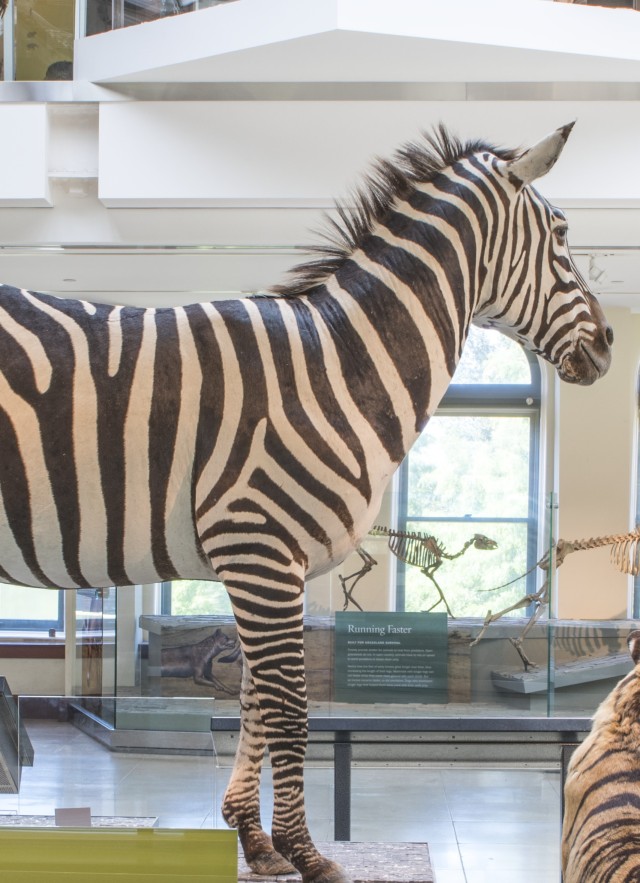
Published March 25, 2025
How can you spot zebra species? By looking at their stripes.
Among the 100,000 specimens cared for in NHM’s Mammalogy collection are eight zebra hides, most with hooves still attached, but given the colorful history of collecting these black-and-white pelts, only three had been identified to species, until now.
Each zebra’s individual striping pattern is like a fingerprint, but the style of those patterns helps zebra experts identify which of the three species any individual belongs to. White bellies, thinner stripes, stripe patterns on the back, and the presence or absence of shadow stripes are all clues to help identify which of the three species of zebra you’re looking at—if you’re a zebra expert. Luckily, one stopped by the Mammalogy collections recently to take a closer look.
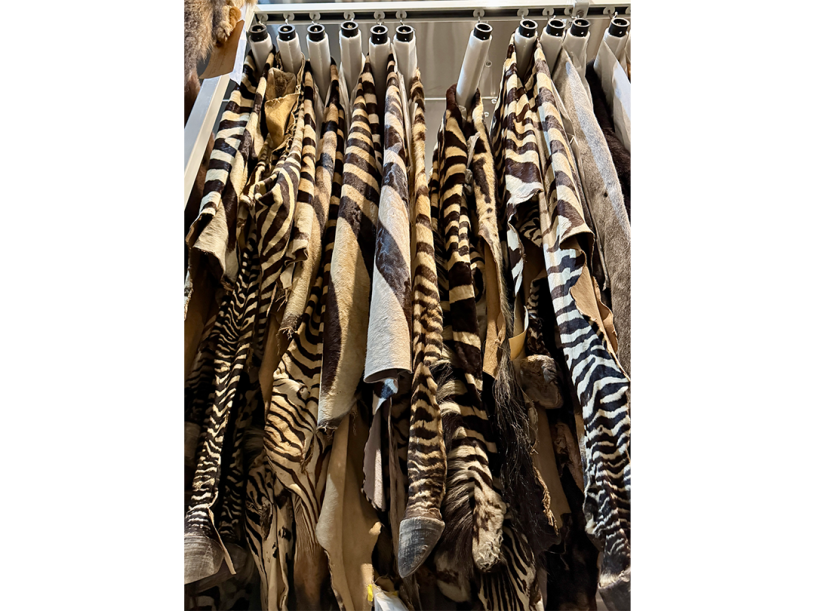
A Horse Researcher Walks Into the Mammalogy Collection
Dr. Alan Vincelette from St. John’s Seminary dropped by (i.e., scheduled a scientific visit) to study the skins as part of his research into the adaptation of horse hooves to different soil types.
“Mountain species seem to have narrow hooves and desert species wider ones, but I need more data for a proper analysis,” says Vincelette, which is why he’s visiting collections like NHM’s.
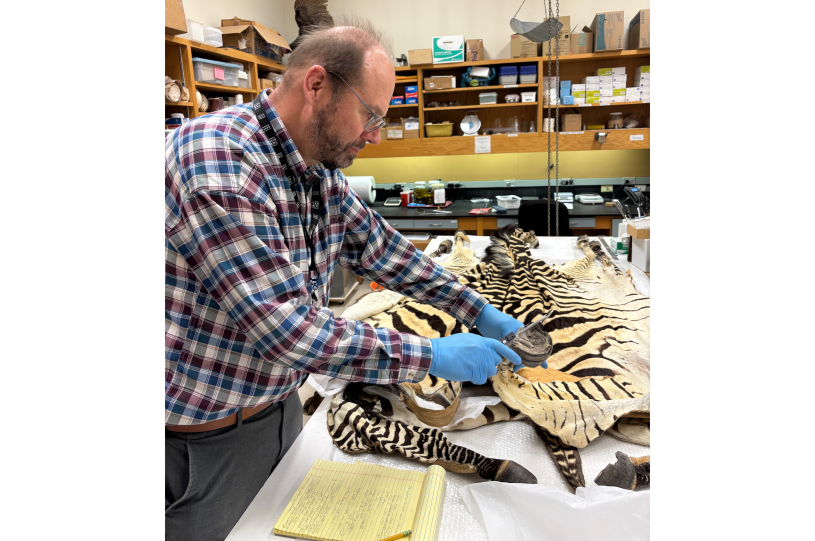
Dr. Vincelette measured the size and angles of hooves from the eight zebra hides in the collections. To make that data useful for his research, he had to first identify the skins to species, discovering that the collection represented a remarkable diversity of zebra species.
“It’s one of the benefits of having collection specimens available to outside researchers,” says Dr. Shannen Robson, NHM’s Mammalogy Collections Manager. While she’s an expert in the complicated practice of caring for mammal specimens of all kinds, as well as other mammalian subjects, Dr. Robson is not an expert in equids, the family of mammals that include horses and zebras (and wild asses).
“Having experts in different groups make use of NHM collections can increase the value of those collections for future research,” says Robson. Some of our oldest specimens have very little information. They might have come from animals kept in local movie studio menageries or circuses. Only three of the eight zebra skins had any catalog record information. Two were from the L.A. Zoo, and one was collected in Namibia, but the other five had no information. Alan was able to identify the rest to species based on pelt patterning.”
Species names and their relationships to each other are constantly being studied and updated based on things like genetic analysis. Older specimens like these zebra hides might have been reclassified since they were initially cataloged at the Museum, notes Robson. “It's great to have an expert who is up to speed on the current taxonomy come in and make those updated corrections.”
Dr. Vincelette found the pelt collections comprised of: one Imperial Zebra (Equus grevy), three Mountain Zebras (Equus zebra), and four pelts of the Plains Zebra (Equus quagga or Equus burchelli, depending on how they're being classified).
Why do zebras have stripes in the first place? The answer isn't black and white. "Modern studies have suggested that the stripes are not just useful in helping zebras identify each other, but may play roles in thermoregulation and making them difficult to spot for predators in certain situations, and the stripes definitely seem to discourage parasite-and virus-bearing flies from attacking them," says Vincelette. "So the next time you go hiking outdoors, maybe wear a striped shirt of your own."
Stripe Guide

Photo by Alan Vincelette
"The collection had four pelts of the Plains Zebra (Equus quagga or Equus burchelli, depending upon the classification scheme) with stripes extending to the belly, including some of the northern forms without shadow stripes and some of the southern forms with shadow stripes or fainter stripes between the dark black stripes," said Vincelette.
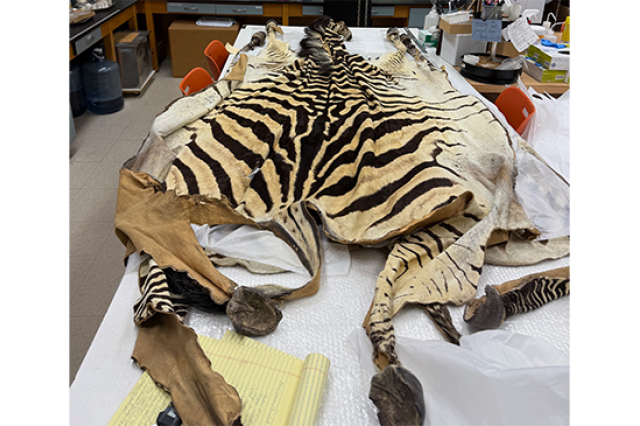
Photo by Alan Vincelette
The shadow stripes help identify this as a southern form of E. quagga.
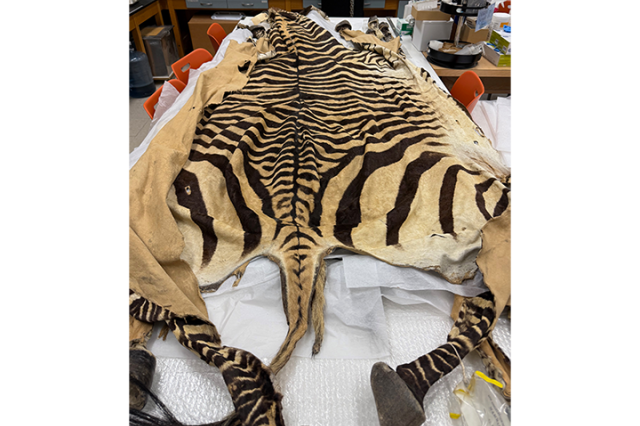
Photo by Alan Vincelette
"There were three pelts of the Mountain Zebra (Equus zebra) identifiable by its white belly, unique grid-iron pattern of stripes on its rump, and small narrow hooves," says Vincelette.

Photo by Alan Vincelette
"The collection had one pelt of the Imperial Zebra (Equus grevyi), which possesses a white belly, a dark dorsal line running down the back surrounded by white bars, stripes on its hind quarters forming concave bowl and chevron patterns, and large wide hooves," said Vincelette.
1 of 1
"The collection had four pelts of the Plains Zebra (Equus quagga or Equus burchelli, depending upon the classification scheme) with stripes extending to the belly, including some of the northern forms without shadow stripes and some of the southern forms with shadow stripes or fainter stripes between the dark black stripes," said Vincelette.
Photo by Alan Vincelette
The shadow stripes help identify this as a southern form of E. quagga.
Photo by Alan Vincelette
"There were three pelts of the Mountain Zebra (Equus zebra) identifiable by its white belly, unique grid-iron pattern of stripes on its rump, and small narrow hooves," says Vincelette.
Photo by Alan Vincelette
"The collection had one pelt of the Imperial Zebra (Equus grevyi), which possesses a white belly, a dark dorsal line running down the back surrounded by white bars, stripes on its hind quarters forming concave bowl and chevron patterns, and large wide hooves," said Vincelette.
Photo by Alan Vincelette
